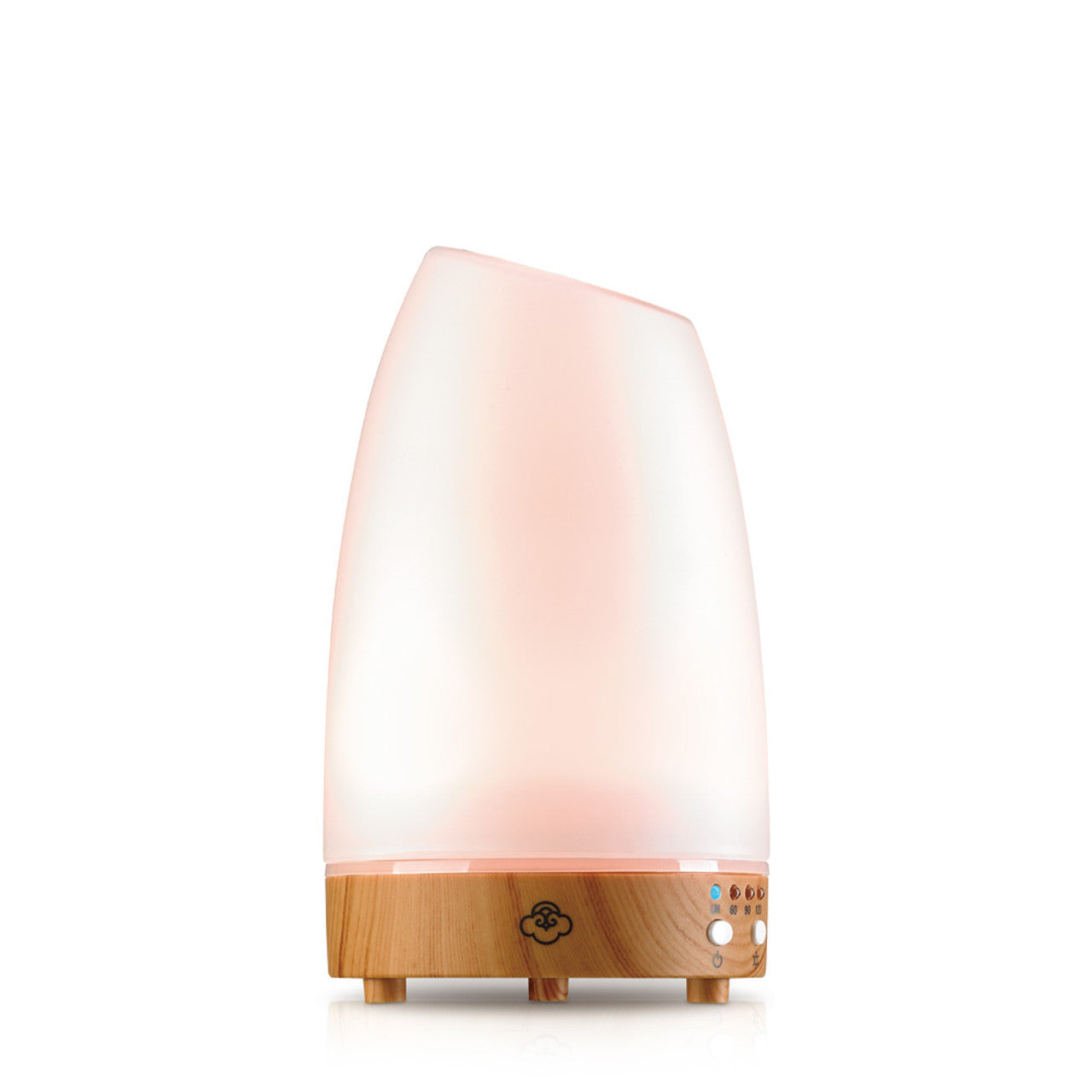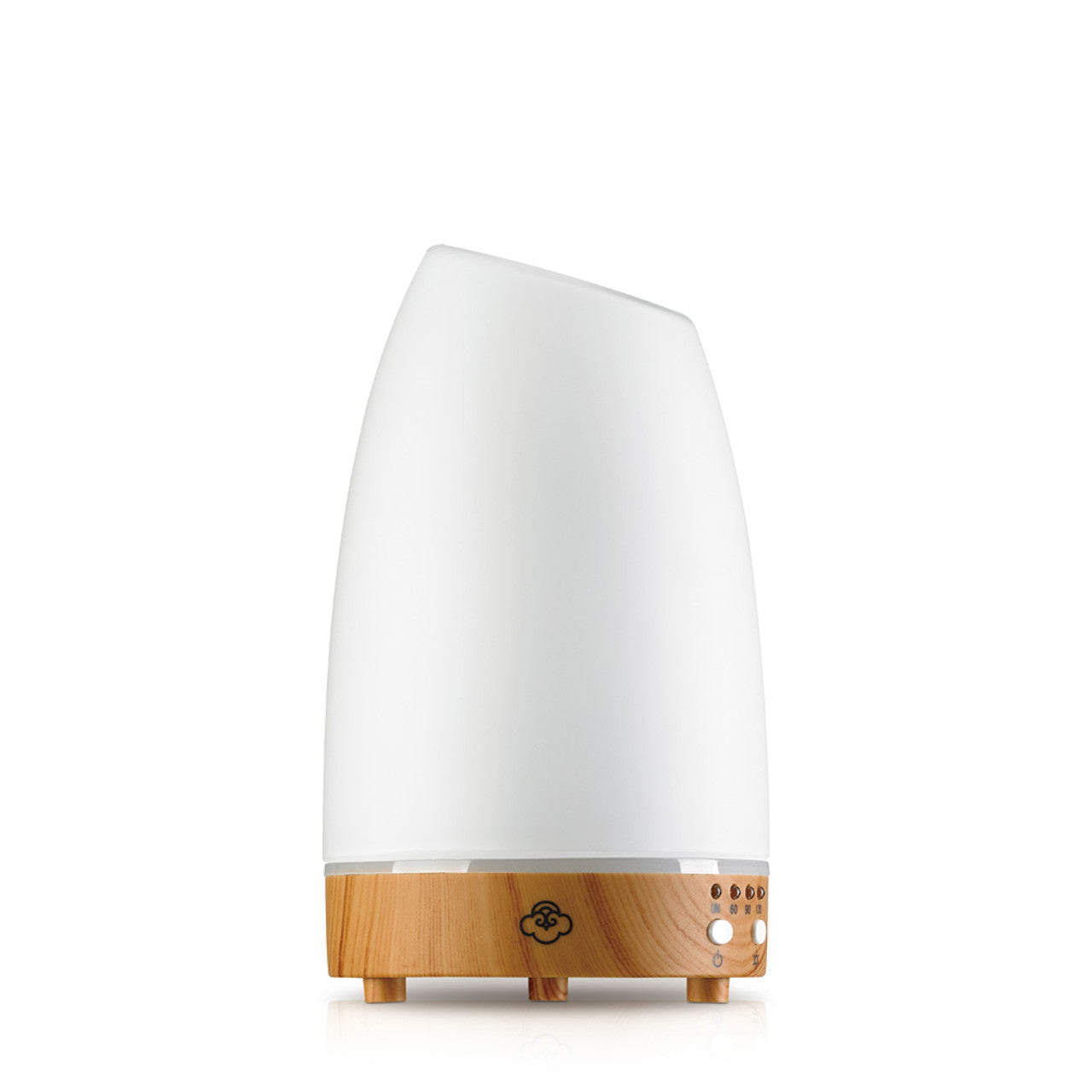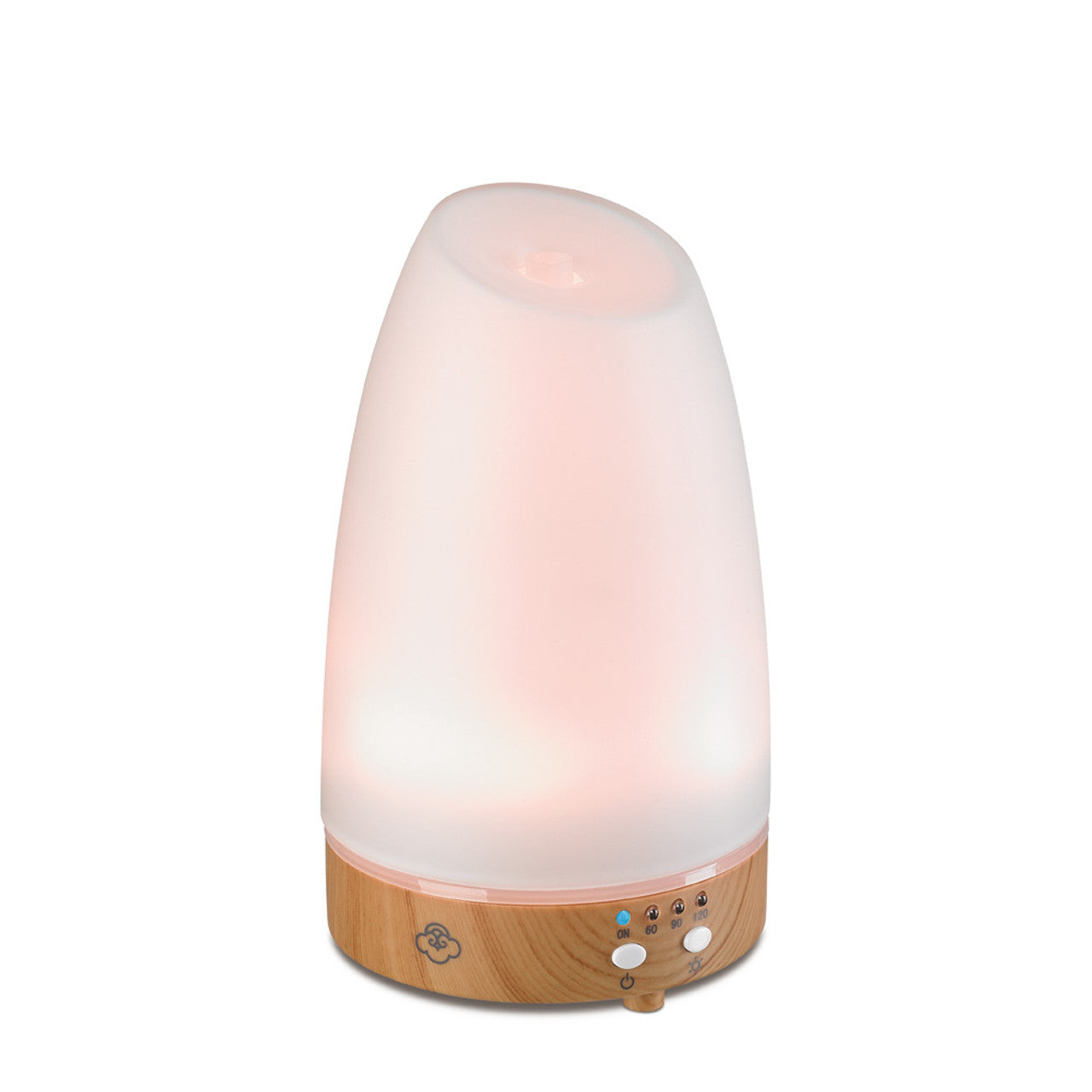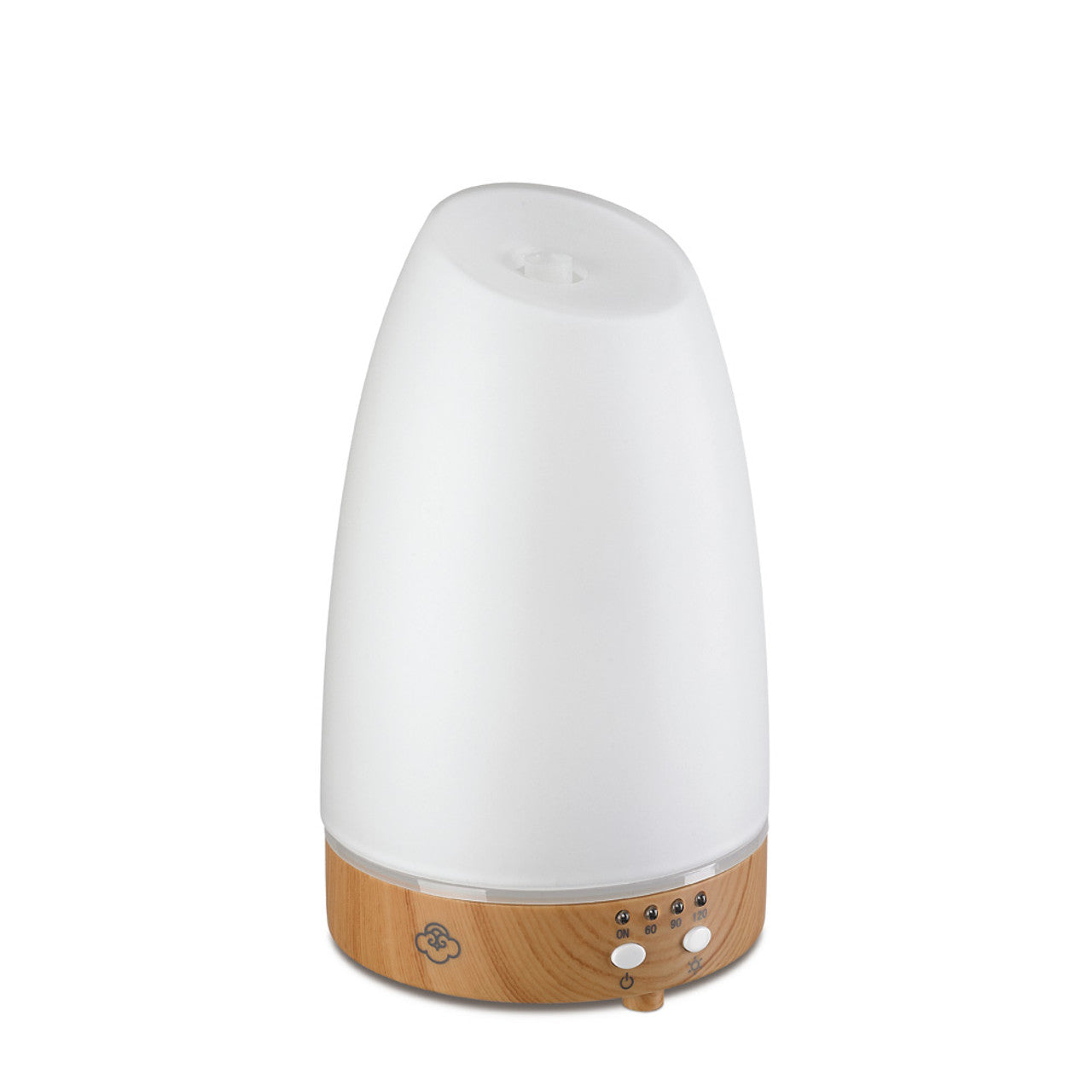Serene House
Astro White Glass Ultrasonic Diffuser with Timer and Rotating LED Light
Astro White Glass Ultrasonic Diffuser with Timer and Rotating LED Light
Couldn't load pickup availability
The Astro White 90ml is a unique essential oil diffuser that combines modern functionality with timeless aesthetics. Its compact size, minimalist design, and frosted glass with a milky white finish evoke the softness of morning mist and the tranquility of nature-inspired interiors. It's more than just a device—it's a subtle accent that can transform the ambiance of an entire room.
Designed for elegant yet cozy spaces, Astro blends harmoniously with both modern and more classic interiors. Its simple, organic lines are set on a natural wood-effect base, creating a beautiful contrast between the glass and the warmth of the wood structure.
Functionality
Astro offers not only aesthetics but also practicality. It allows:
continuous operation for up to 4 hours, or intermittent operation for up to 8 hours, and thanks to the timer you can set the device to work for 60, 90 or 120 minutes.
Built-in 7 delicate LED lights (with the option of setting a fixed color) create an atmosphere conducive to calm, concentration or evening relaxation.
Simply add water and a few drops of your favorite essential oil to instantly fill your space with a soothing mist of fragrance and light. The diffuser automatically shuts off when the water level gets too low, ensuring safe use.
Materials
Glass: Thick, milky white, matte glass with a velvety structure, gently diffusing light.
Wooden texture: Finished in a natural wood tone that warms the form and adds natural charm.
Design and Purpose
Astro is perfect for a bedside table, a dresser in the living room, in the bathroom, or in the office. Thanks to its subtle presence, it doesn't dominate the interior—it rather complements it. It's an excellent choice for those who value minimalist elegance and products that, in addition to their function, also offer aesthetic value.
Optimal Use
Designed for rooms measuring 15-25m², this diffuser produces a cool mist that gently humidifies the air and provides aromatherapy without heating the oils. Additionally, it features an automatic shut-off function when the water level is low, ensuring safety and comfort.
Dimensions
Width: 9.00 (cm) Height 15.50 (cm) Depth: 9.00 (cm).
Serene House is a renowned aromatherapy brand that combines modern technology with elegant design, the highest quality of workmanship and attention to detail.
Share




Worth knowing before use
How to clean and maintain a diffuser?
According to the manufacturer's recommendations, to ensure optimal performance of the diffuser:
- Clean the tank after each use.
- Once a week, rinse the inside thoroughly with warm water (max 40°C) and a mild detergent.
- Do not use harsh cleaners or acidic detergents.
- Be careful not to let water get into the ventilation holes.
- If the ventilation system is accidentally flooded, wait 6 hours before using it again.
Tips for using your diffuser
- Always place the diffuser on a stable, flat surface.
- Fill the tank with water below the maximum level (MAX).
- Add 2-10 drops of your favorite essential oil to the water.
- Place the ceramic lid on gently to avoid damaging it.
- Plug the power adapter into the socket and then turn on the device.
- The power button activates the mist and LED backlight.
- The light button allows you to choose one of 7 colors or turn off the backlight completely.
Diffuser operating modes:
- When you press the first button, the continuous mist starts.
- Pressing the button a second time turns on the intermittent mist - I particularly recommend this function because it ensures a gentler, longer diffusion.
- The second button allows you to turn on or change the backlight color, or leave the diffuser without light.
Additional recommendations
- Use soft water or bottled water – distilled water is not recommended.
- Always unplug the diffuser after use.
- Essential oils may cause discoloration – if they come into contact with the housing, wipe the surface immediately.
- Take care of your diffuser – with proper care, it will retain its beautiful appearance for longer.
Safe and effective use of essential oils
Essential oils are concentrated, natural plant extracts with powerful aromatic and biological properties. To fully utilize their properties—while maintaining safety—it's worth understanding the basic principles of their use.
1. Inhalation – the simplest and safest method.
Inhalation is one of the most effective and gentle ways to use oils.
There are several ways to do this:
- Ultrasonic Diffuser – Add 3–6 drops of oil or blend per 100 ml of water. The diffuser disperses microscopic oil particles into the air, allowing for gentle, even absorption through the respiratory tract.
- A fragrance stone or wooden carrier – perfect for the office, bedroom, or car. Personal inhalation – apply 1–2 drops to a tissue or inhale from the palm of your hand.
2. Application to the skin – always in appropriate dilution
Essential oils are highly concentrated, so never use them undiluted (the exception may be spot-on use of certain oils, such as lavender or tea tree, only after consulting an aromatherapist). Always combine them with a carrier oil.
Tisserand and Young dilution:
- Adults: 2–3% (approx. 6 drops per 10 ml of carrier oil)
- Sensitive skin, elderly: 1%
- Children over 2 years of age: 0.5–1%
- Pregnant women: up to 1%, only after consultation with a specialist.
Most commonly used base oils:
Jojoba, sweet almond oil, grapeseed oil, fractionated coconut oil, or apricot kernel oil. After preparing the mixture, always perform a patch test – apply a small amount to the inside of your forearm and wait 24 hours to rule out an allergic reaction.
3. Aromatherapy baths
Add 3–5 drops of essential oil or blend, previously diluted in a tablespoon of vegetable oil, milk, or natural honey. Do not add oils directly to water – they are insoluble and may irritate the skin.
4. Observation and individual reaction
Everyone reacts differently. If you experience any discomfort, headache, dizziness, shortness of breath, or skin irritation, discontinue use immediately. Some people may require a lower concentration or a shorter diffusion time (e.g., 30 minutes per day instead of 2 hours).
5. Storage
Essential oils should be stored in tightly sealed glass bottles, away from light, heat, and moisture. We recommend storing oils in a cool, dark place (1-5°C), away from direct sunlight. This will reduce oxidation and preserve their quality longer. Properly stored oils (e.g., in the refrigerator) age much slower than those kept warm, even if the bottle is unopened. Some oils (e.g., cold-pressed citrus oils) should be stored in the refrigerator to prevent oxidation. Always keep the cap on the oil. Tightly close the bottle after each use to minimize exposure to air.
6. Transparency and quality
- Pay attention to: The botanical (Latin) name – e.g. Lavandula angustifolia, not “lavender oil”.
- GC/MS batch – chromatographic analysis confirming chemical composition.
- Method of extraction (steam distillation, cold pressing, etc.).
- Country of origin – plants from different regions have different fragrance profiles and compositions.
- At AromaPremium, each oil has a full GC/MS card and a description of its properties and safety in accordance with the scientific literature.
7. Security
- Avoid contact with eyes, mucous membranes and wounds.
- Do not use internally (orally) without consulting a certified aromatherapist or physician.
- Some oils (e.g., bergamot, lime, lemon) are phototoxic – do not apply them to the skin before sun exposure. Keep out of reach of children.
- In case of chronic diseases, pregnancy or lactation – consult your doctor.
8. Trust your body and your scent
Aromatherapy is a subtle practice. If a scent doesn't suit you or makes you feel unwell, it's a sign to choose a different oil. A scent that soothes you today may invigorate you tomorrow – listen to your body, as its reactions are your best guide.
First aid – what to do if oil gets into your eye?
Contact of essential oil with the eye
Symptoms: redness, tearing, burning; the child may rub his eyes vigorously.
What to do (first aid):
- Rinse your eye with plenty of cool water for 15–30 minutes as soon as possible. The most important thing is the strong rinsing effect – that's why water is better than oil here (it's the mechanical removal of the oil that counts).
- How to rinse effectively: fill a bowl/sink with water, immerse your face and open
and close your eyelids, move your eyeball in different directions. You can
also rinse with a gentle stream from the tap/shower. - Contact lenses: Remove after the first 5 minutes of rinsing, then continue rinsing. Do not reinsert until symptoms have completely resolved.
- Make sure you rinse properly: gently spread your eyelids apart with your fingers to allow the water to reach everywhere.
- If irritation persists (severe pain, redness, tearing,
photophobia, blurred vision) after 15–20 minutes of rinsing – urgently
Contact an ophthalmologist or go to the emergency room. Take a bottle of oil with you.
What not to do: do not rub your eye, do not use alcohol or "brightening" drops, and do not put pure oils in your eye.
Essential oil ingestion
Note: Poisoning most often occurs in small children who drink the contents
bottles. A "large dose" depends on the type of oil and body weight. Take each case seriously.
Symptoms: irritation
mucous membranes, abdominal pain, vomiting, diarrhea; in severe poisoning
Convulsions, CNS depression, and even liver and kidney damage are possible.
What to do (first aid):
- Do not induce vomiting. There is a risk of aspiration (contents entering the lungs).
- If the injured person is conscious and not having convulsions, rinse the mouth with water, do not give alcohol.
- Call a medical professional immediately (112) or a poison control center. Provide the name of the oil and approximate quantity.
- If the injured person is having convulsions or is unconscious, do not give anything.
orally; open the airway and place the patient in the recovery position (on the
side, head lower than the body). - Take a bottle of oil to the hospital – this will make it easier to assess toxicity.
- Activated charcoal is considered ineffective in essential oil poisoning.
Prevention: keep oils out of reach of children and animals, do not pour into beverage/medicine containers; do not use orally without the supervision of a qualified professional.






